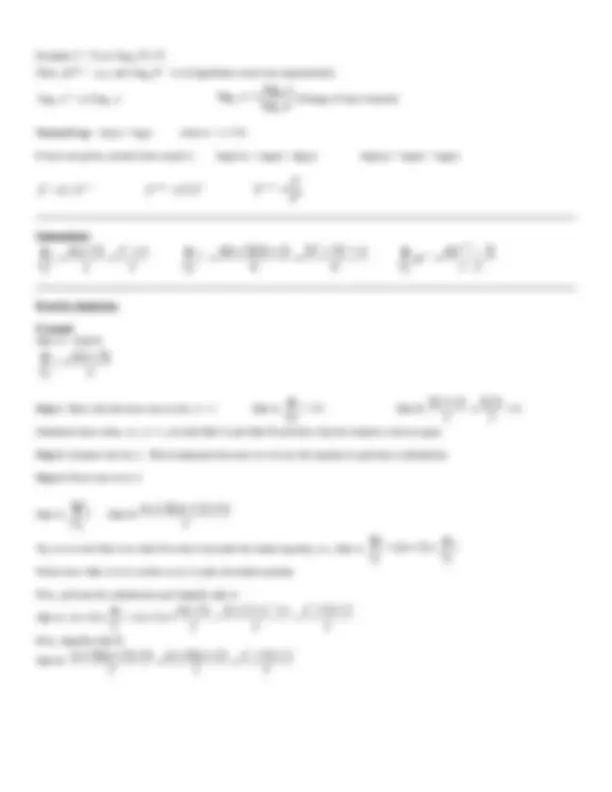



Study with the several resources on Docsity

Earn points by helping other students or get them with a premium plan


Prepare for your exams
Study with the several resources on Docsity

Earn points to download
Earn points by helping other students or get them with a premium plan
Community
Ask the community for help and clear up your study doubts
Discover the best universities in your country according to Docsity users
Free resources
Download our free guides on studying techniques, anxiety management strategies, and thesis advice from Docsity tutors
A comprehensive review of various mathematical concepts including sets of numbers (natural, real, integers, rational), cardinality, polynomial functions, set notation, sequences, logic, permutations, combinations, logarithms and exponents, and proof by induction. It covers topics such as polynomial functions of degree n, set notation [a, b] and (a, b), permutations and combinations, binomial coefficients, logarithms and exponents, and proof by induction.
Typology: Study notes
1 / 2

This page cannot be seen from the preview
Don't miss anything!


Sets of Numbers
- Natural numbers {1, 2, 3, 4, …} positive whole numbers, infinite, countable
- Real numbers (i.e., floating point numbers) infinite, not countable
Integers both non-negative and negative whole numbers {…-2, -1, 0, 1, 2, …}, includes zero, countable
Rational numbers can be expressed as a fraction of two whole numbers (i.e., 0.25 = ¼), countable
2 is^ not^ rational, i.e., can not be expressed as a/b where a and b are whole numbers.
Cardinality
If X is a finite set, |X| is the number of elements in the set.
Polynomial of degree n
1 0
2
2
2
2
1
1
n
n
n
n
n
n
Example:
3x
3 +5x
2 +4x+x
4 Polynomial of degree 4 (a common trick in this course)
Set Notation
[a, b] All the number between a and b , including both a and b.
(a, b) All the number between a and b , excluding both a and b.
Examples:
[3, 6] = {3, 4, 5, 6} assuming a and b are integers. (1, 2) = { } [1, 3) = {1, 2}
[3.0, 6.0] is infinite, assuming a and b are Real Numbers
Sequences are like sets except the order of the elements matter.
Given a = 1, 2, 3 and b = 3, 1, 2 , the sequences a and b are not equal.
Sequence a[n] = a 0 , a 1 , a 2 , …, an-
1, 5, 6, 10, 14, 23 increasing sequence 9, 6, 5, 3, 2 decreasing sequence
1, 2, 2, 6, 7, 7 non-decreasing sequence 9, 9, 9, 5, 4 non-increasing sequence
3, 7, 10 is a sub-sequence of a = 1, 3, 4, 7, 8, 10
Logic
p q^ r interpreted as (( not p) and q) or (not r) Can also be written as ~pq+~r
~pq is true when p = 0 and q = 1. Also, ~r is true when r = 0.
Thus, ~pq+~r is true when r = 0 or when p = 0 and q = 1.
Permutations - number of different orderings (analogous to sequences).
Given {a,b,c}, there are 3! = 6 permutations (abc, acb, bca, bac, cab, cba).
Combinations - number of different subsets (order does not matter).
Given {a,b,c}, there is one combination of size 3.
Given {a,b,c,d} there are 4 combinations of size 3 (abc, bcd, cda, dac).
Binomial coefficient counts the number of combinations, i.e., the number of k-element subsets of an n-element set.
n k k
n
k
n
Logarithms & Exponents
Example 2
3
2
Thus,
x b
log
x
b
b
y
b
a
x
x
b
b
a log
. log
log (Change of base formula)
Natural Log = ln(x) = logex where e = 2.
If base not given, assume base equals 2. log(x/y) = log(x) - log(y) log(xy) = log(x) + log(y)
1 2 2 2
n n n m n m 2 22
m
n
n m
2
2
2
Summations
2 2
( 1 )
2
1
nn n n
i
n
i
6
2 3
6
( 1 )( 2 1 )
3 2
1
2 nn n n n n
i
n
i
1
( 1 )
1
1
r
a r
ar
n^ n
i
i
Proof by Induction
Example
Side A = Side B
2
( 1 )
1
n n
i
n
i
Step 1 : Show that the base case is true: n = 1 Side A: 1
1
1
i
i Side B: 1
Substitute base value, i.e., n = 1, on both Side A and Side B and show that the numeric value is equal.
Step 2: Assume true for n. This is important because we can use the equality to perform a substitution
Step 3: Prove true for n+
Side A:
1
1
n
i
i (^) Side B:
Try to re-write Side A or Side B so that it includes the initial equality, i.e., Side A:
n
i
n
i
i n i
1
1
1
( 1 )
Notice how Side A is re-written as (n+1) plus the initial equality.
Now, perform the substitution and simplify side A:
Side A:
2
3 2
2
2 2
2
( 1 )
( 1 ) ( 1 )
2 2
1
nn n n n n n
n i n
n
i
Now, simplify side B.
Side B:
2